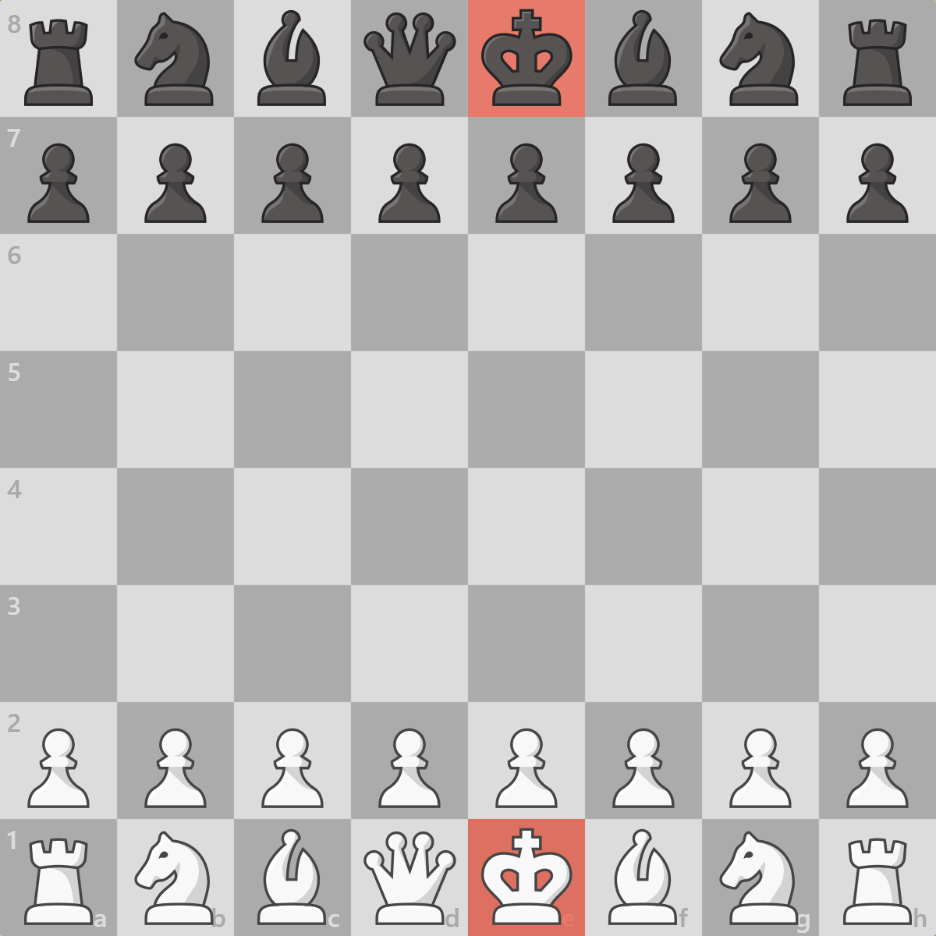
- Basics, Learning, Rules
- March 17, 2022
- 6:52 pm
How Do You Setup A Chess Board?
It can be challenging for new chess players to remember how to setup the board. It’s even more confusing given that the board is perfectly square.
It is the most fundamental part of your training to memorize where each chess piece stands. If you have yet to learn the basics, you’re in the right place.
Follow these easy steps when you set up a chessboard for your chess game and repeat them until they become automatic every time the chess set is in front of you.
How do you orient a Chess Board?
When you lie the board on a flat surface, make sure that the lighter square is on the bottom right corner.
Before putting any pieces on the board, this is the most important thing you should do first, as the wrong orientation means the pieces will not be appropriately positioned.
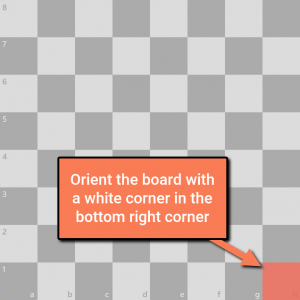
What is the correct way to Set Up a Chess Board?
- Player 1 (White): Uses squares 1A – H and 2A – H
- Player 2 (Black): Uses squares 8A – H and 7A – H
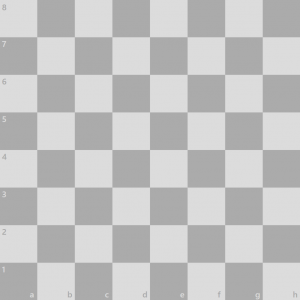
How do you set up a Pawn in Chess?
Before you get down to the chessmen with higher ranks, put your pawns down first. Think of them as the first line of defense before the higher-ups show themselves during a battle.
They are usually the smallest pieces in your set, and there are 8 of them. They are positioned on the second rank or row in a straight line.
- Player 1 (White): The pawns go on the vertical row with a “2” and line them all the way from A – H
- Player 2 (Black): The pawns go the “7” vertical row and also go from horizontal columns of A – H
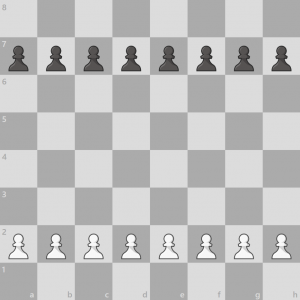
Pawn set up
Put all of your 8 pawns in a line across the second row, also known as ranks. Doing this is also very strategic because it clears up your pile of pieces to make sorting through them easier in the following steps.
Where do you put Rooks?
Aside from the pawns, the rook has the easiest position on the chessboard.
A set has two rooks for both black and white. They go on the bottom corners of the chessboard.
- Player 1 (White): Rooks are set on 1A and 1H
- Player 2 (Black): Rooks are positioned at 8A and 8H
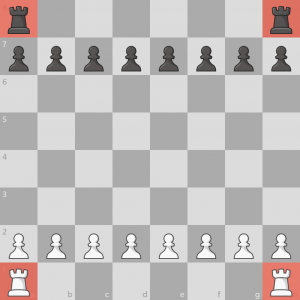
How do you set up Knights in Chess?
The horse-shaped pieces are also called knights, and they go besides the rooks. Think of them as guardians of the tower while at the same time keeping the smelly horses away from royalty.
There are also two knights per player, and they go right beside the rooks.
- Player 1 (White): Place knights on squares 1B and 1G
- Player 2 (Black): Place knights on squares 8B and 8G
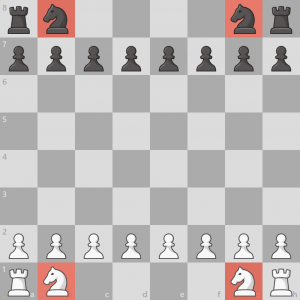
Knight set up
Where do you place the Bishop in Chess?
The pieces with rounded tips are called the bishops, and they are positioned beside the knights. They serve as the barricade between the royals and those smelly horses.
Each player has 2 bishops, and they go besides the knights.
- Player 1 (White): The bishops go on the squares 1C and 1F
- Player 2 (Black): The bishops go on the squares 8C and 8F
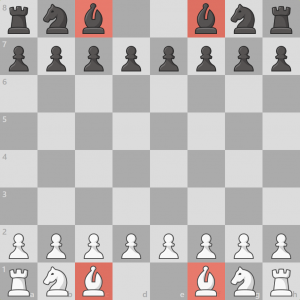
It is understandable that you are confused about where to put your queen and king. They are royalty, and they can stand wherever they (you) want on the chessboard, right?
Wrong! A lot of novices make the mistake of thinking that it doesn’t matter which square the king and the queen are placed in, but it does!
Where do you put the Queen Chess?
Interchanging their position means you have not successfully learned how to set up a chessboard, but undoing this mistake is easy. To make it easier to remember, always keep in mind that the queen is always fashionable and wants to match her colors.
This is the most important and powerful chess piece on the board at any given time and there is only one per player. It is also the one that is most commonly misplaced.
To remember where the queen goes without relying on the labels, just think that the queen has to match the color of the square. Meaning, the black queen goes on the black square and the white queen goes on the white square.
- Player 1 (White): Positions the Queen on square 1D
- Player 2 (Black): Positions the queen on square 8D
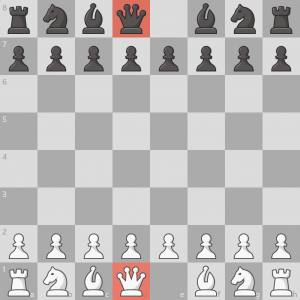
Where do you place the King on a Chessboard?
The king is the last piece to put on the board, and he goes on that last square left. It is easy to put him in his rightful place when his queen is right beside him in her rightful place as well.
This is the piece that needs a lot of protection. Once a king is captured or trapped by the opposing player, the game ends.
This is why each player’s single king piece is kept in the middle of all the pieces to fully shield it from capture and entrapment.
- Player 1 (White): Places the king on square 1E
- Player 2 (Black): Places the king on square 8E
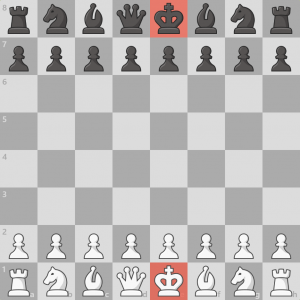
Compare Sides on Chess Board
Once you are done setting up your side, take a look at your opponent’s Chess Board setup. They should perfectly mirror each other if all the pieces are in their correct places. If they are not, it means one of you has misplaced their pieces.
Usually, players confuse the placement of the king and queen and this causes delays and distractions. Always remember their respective spots on the chessboard and keep practicing setting them up until it becomes second nature.
Practice and Mastery
At first, it will be slightly confusing to remember where chess pieces go correctly. Since there are 64 equally sized squares on the board it is very normal to feel overwhelmed.
Novice chess players with boards that are labeled are still prone to confusion and mistakes during their first few games, but eventually, the more you practice and chess, it will become second nature to set your chess pieces in the right positions.
Don’t worry if you feel at a loss with all the different pieces, you will eventually master the correct placement.
The game of chess is all about strategy, skill, and intellect, which means rules and proper placement of all the chess pieces is a must to correctly play a chess game. All chess grandmasters started out as novices, but with continued practice and determination, they have achieved the expertise that they have now.
Expect to lose some chessmen once in a while, especially a queen, which is considered the most powerful piece yet is so easily misplaced. The important part is learning from your mistakes so you can avoid them in future games.
Read also
How to become a Chess Grandmaster
The Sicilian Defense: A Comprehensive Overview
5 Beginner Mistakes to Avoid in Chess
Best Chess Software for PC [Top 5]
Best Chess Software for Mac [Top 5]
